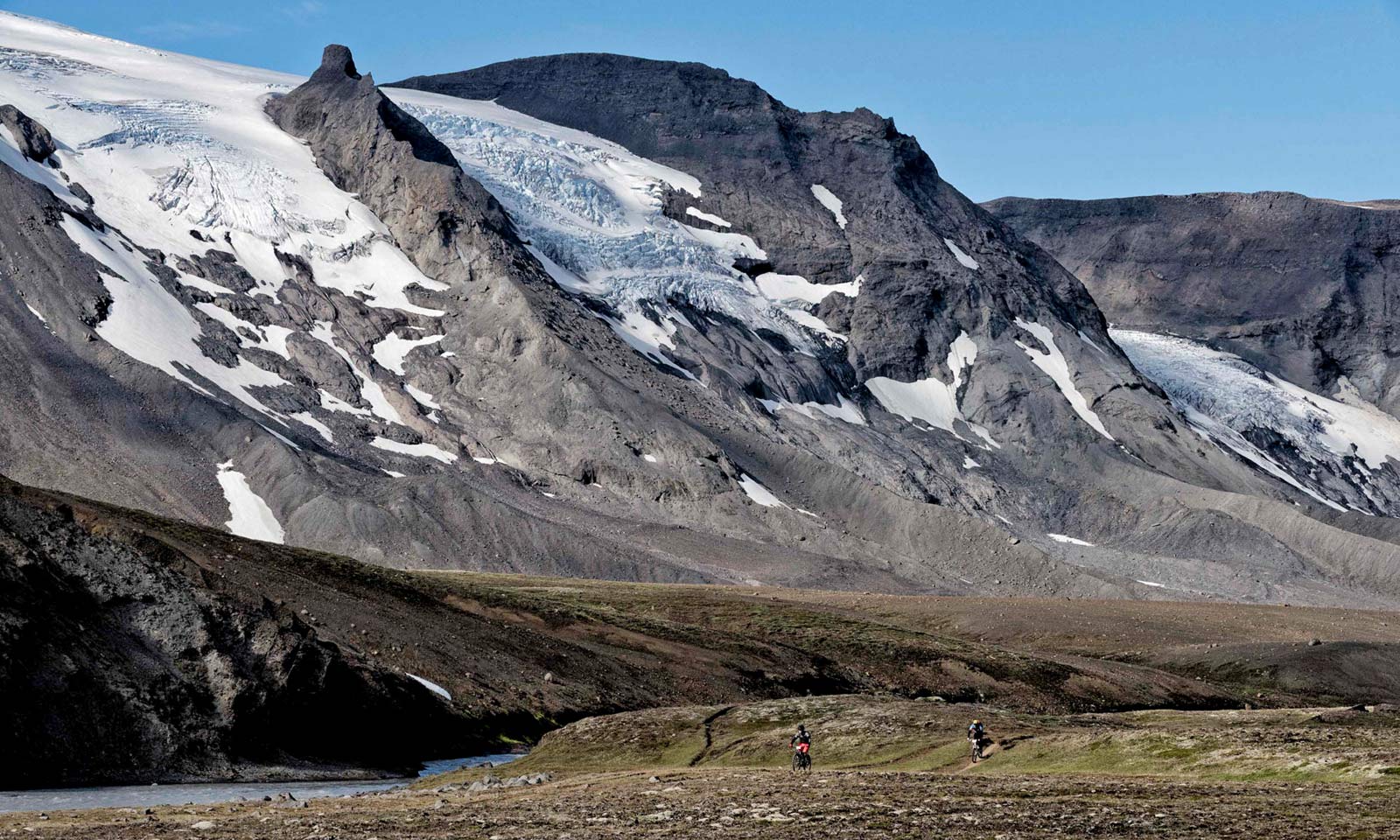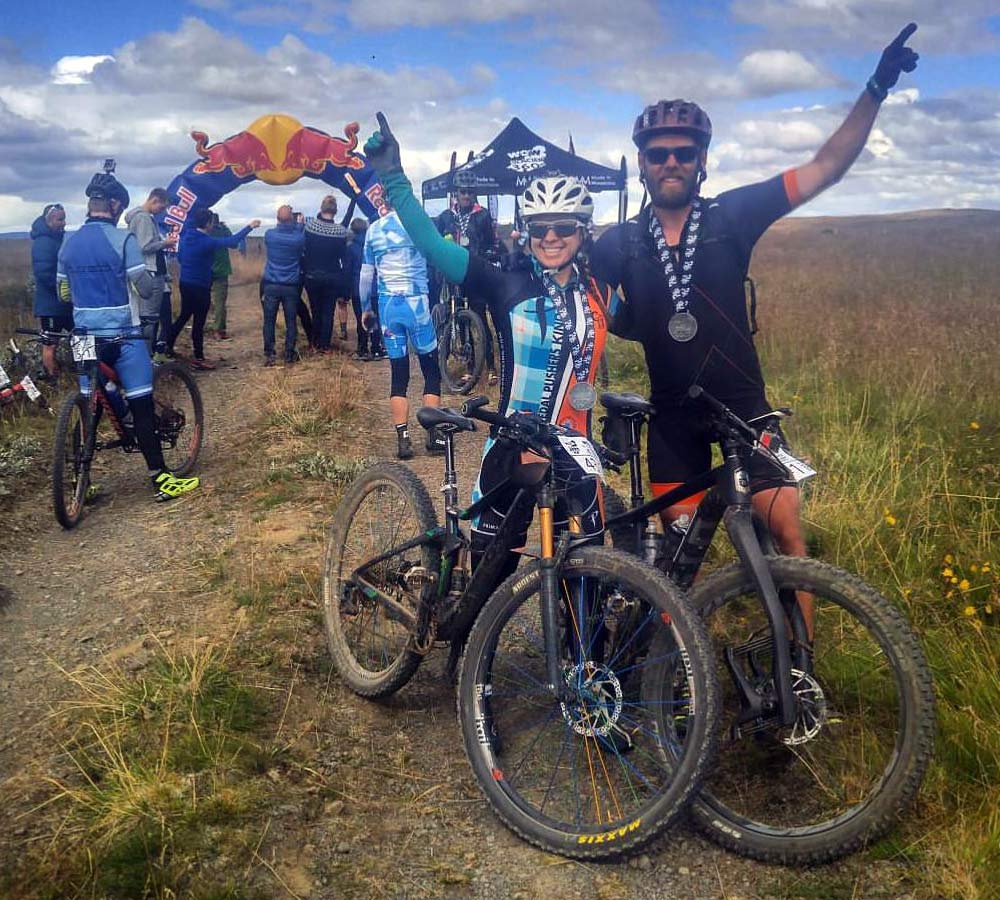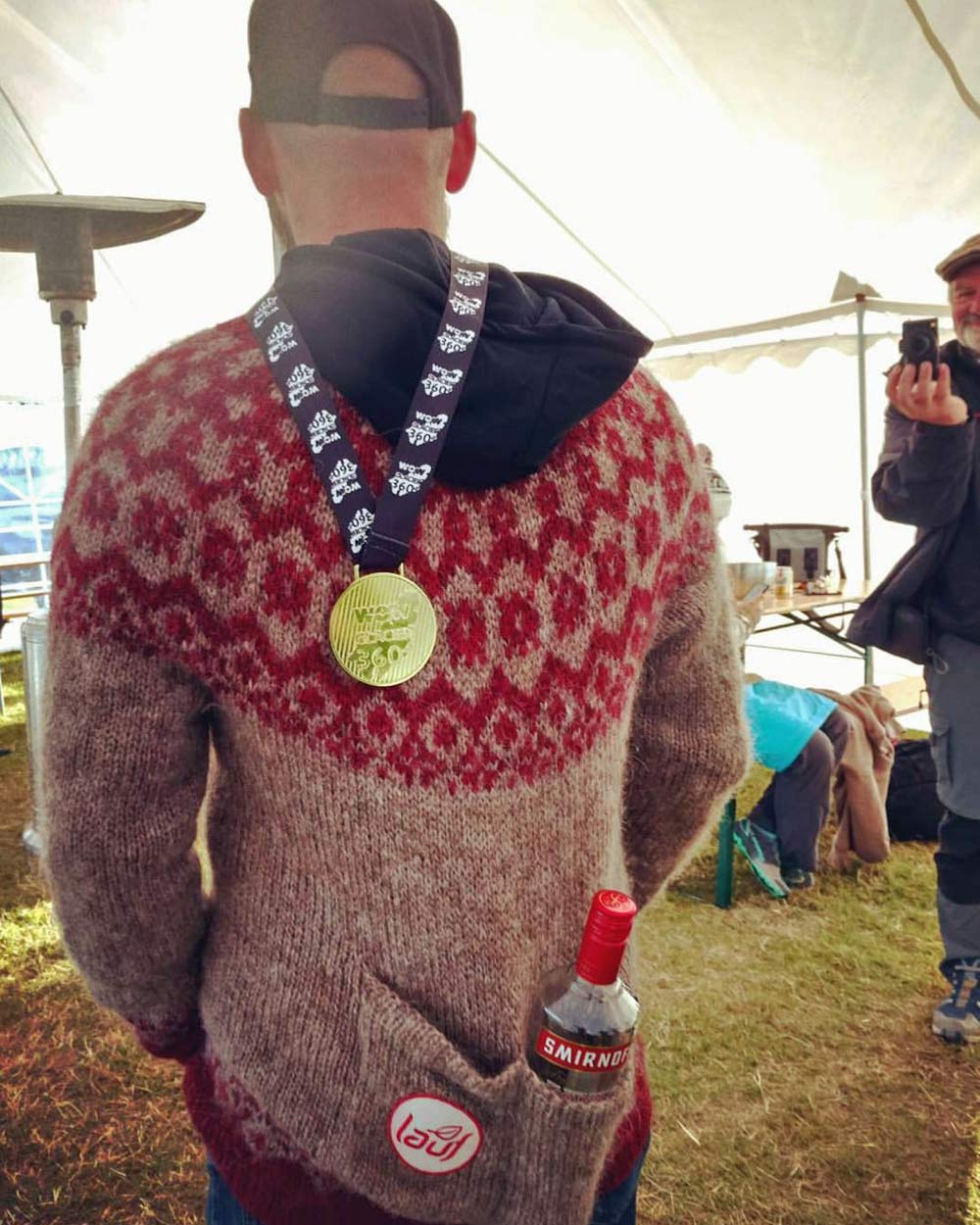We’re always suckers for a unique place to ride. So when adventure mountain biker, and just all around adventurer Elizabeth Sampey sent us a bunch of photos and an enthralling write-up from Iceland’s Glacier 360 multi-day endurance mountain bike stage race, we felt obligated to share. Liz’s write-up chronicles the three-day 2017 running, but the next edition of the Glacier 360 is set to roll out next August 8-11, 2019 with an extra prologue day on the bike and a first for Iceland UCI S2 ranking. Registration is live now at Glacier360.is if you want to give the experience a try yourself.
Until then, just read on and soak up the visuals…
Braving Iceland’s Raw Beauty at the Glacier 360 Stage Race
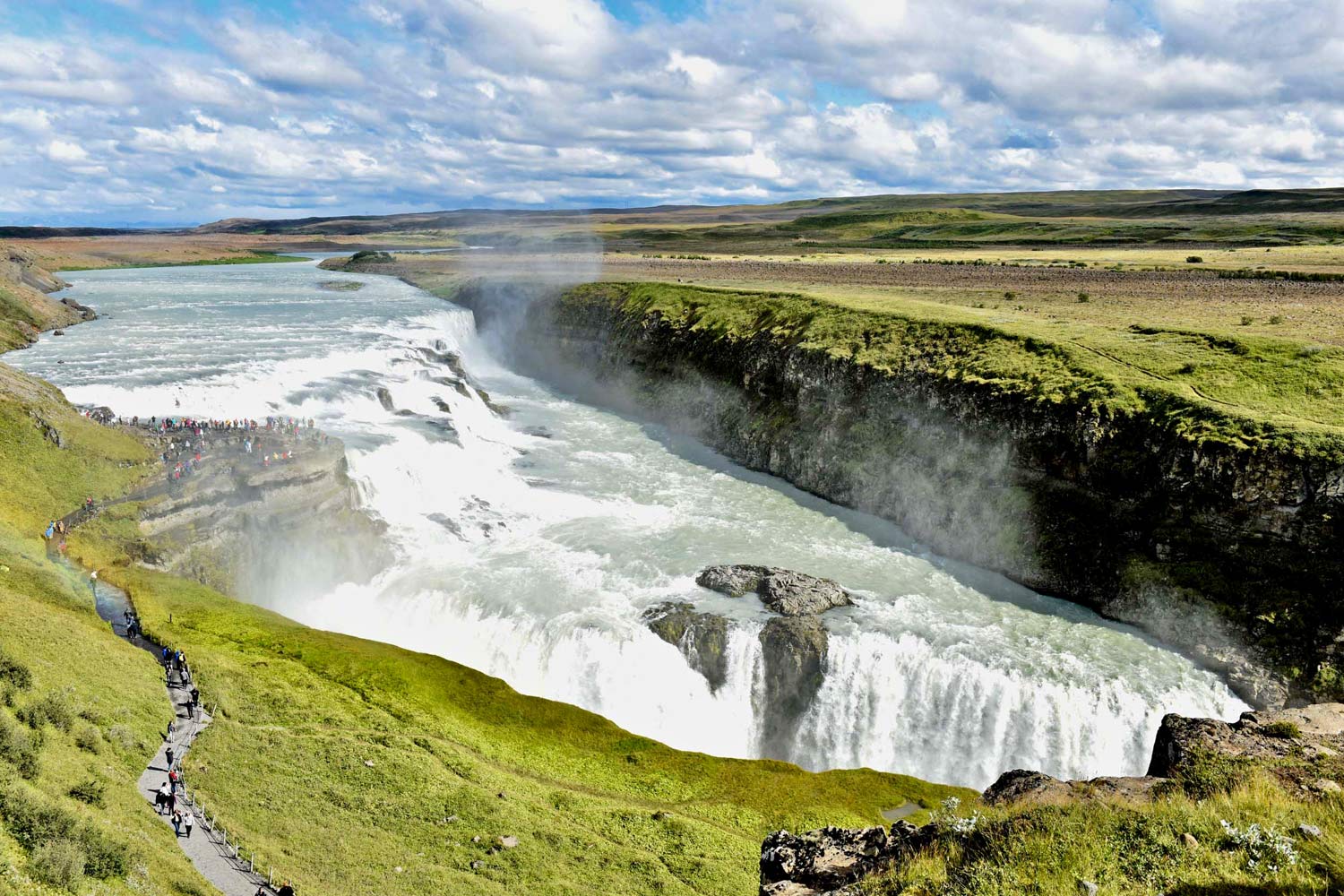
“A three-day international endurance stage race, in Iceland? Yeah, I’m in!” My good friend Bergur Benediktsson, an Icelandic adventurer who works for Lauf Cycling, had invited me to be his teammate for the 2nd running of the Glacier360. It was a race circumnavigating the giant Langjökull glacier, and I jumped at the chance to return to this remote, harsh, and visually mind-blowing country.
I had been to Iceland two years earlier on a film trip for First Tracks Productions’ Off The Beaten Path, where Bergur and I had met, and had gotten a good taste of what Iceland had to offer through off-trail riding on a fat bike. This was my chance to test my mettle on technical singletrack, doubletrack, and Iceland’s infamous mountain “roads” on my [marathon] racing mountain bike.
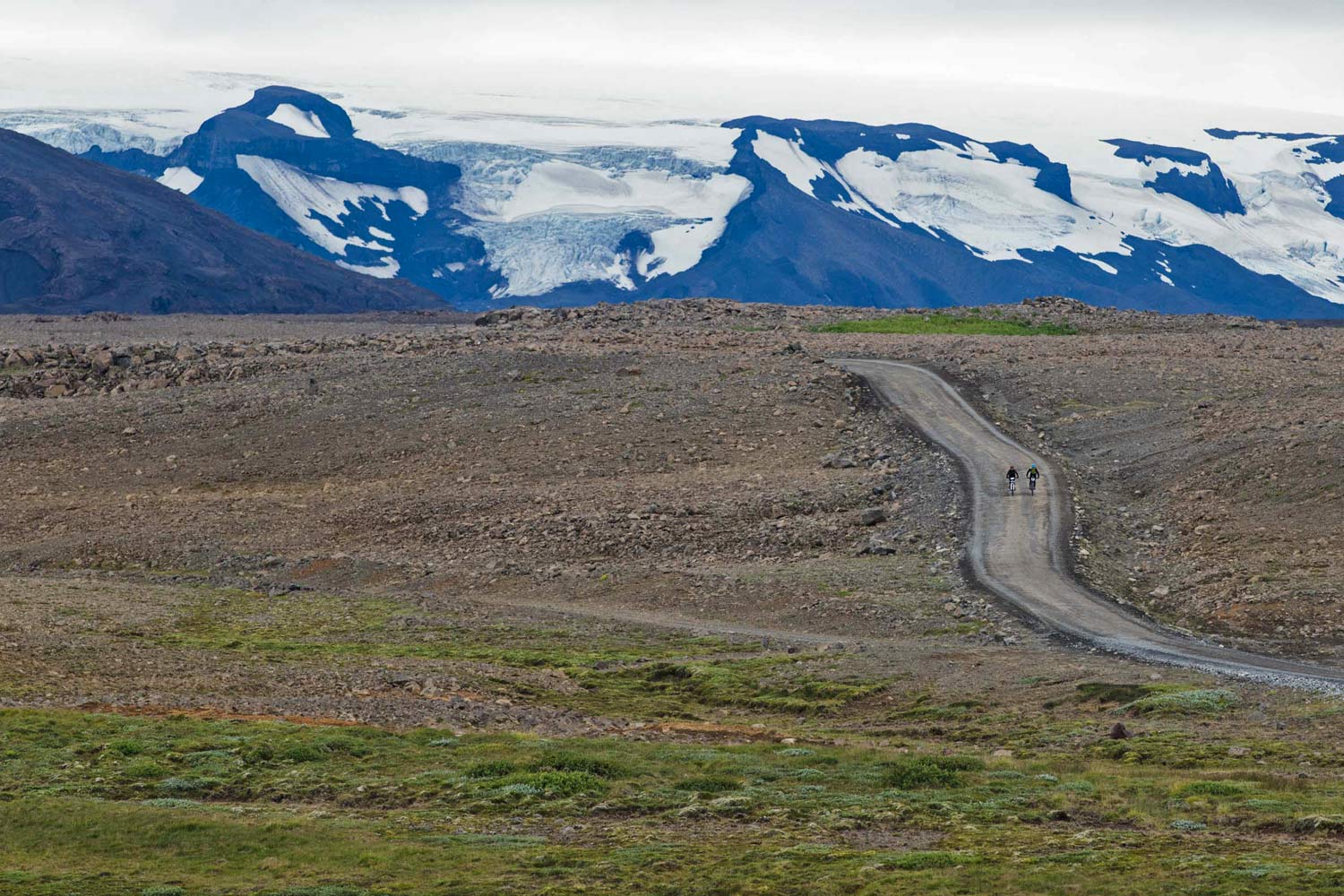
I had also gotten a good taste of Iceland’s infamous weather on that film trip. Winds that had literally blown me off my bike, icy rain, dense fog that rendered any navigational skills useless, and temps that never rose much above 50 degrees even at the height of summer. I had been inspired by the Icelandic athletes I had met who were as rugged and determined as the conditions through which they were accustomed to riding. With huge smiles, boisterous attitudes and unending cheerfulness, they had led the filming team through the gnarliest weather and terrain. Their attitudes and our laughing at the ridiculousness of it all had made riding in the challenging conditions fun.
Besides, those of us crazy enough to travel around the world competing in endurance races do it to challenge ourselves, and what could be better than combining hard racing with wild weather, with a good friend and local Icelander as a teammate? Yeah, sign me up.
At the pre-race meeting, we were all given giant drybags from Ortlieb to pack our sleeping bags and all the clothing we might need over the next three days in. I had to laugh — only in Iceland would a handed out race duffle be a giant drybag. I stuffed as many warm clothes as I could in there for both riding and camp, complete with a few giant Icelandic wool sweaters, gloves and socks borrowed from Bergur (and hand-knitted by none other than his mom). I was ready for any conditions the Icelandic weather gods would throw at me.
GLACIER360 – DAY ONE
The next morning, we all pulled up to the start line just a 90-minute bus ride from Reyjkavik bright and early. Surprise — it was warm and sunny! Many international racers were cruising around in just their spandex. I knew better. We were starting in a sheltered valley, and we were heading up into the mountains to ride next to a glacier. It was going to get chilly, and Icelandic weather can turn on a dime. I pulled on my leg warmers and long sleeved jersey. Bergur, in true local fashion, wore as little as possible. “I’m already sweating my ass off!” would become his signature line over the next 3 days. I just rolled my eyes and laughed.
We lined up under the giant Red Bull banner and were off! We started on a 4WD road with plenty of rocks to navigate around as well as a pack of racers: pros, amateurs, men and women alike, all riding in teams of two. I made my way up near the front as quickly as possible, Bergur on my wheel. With my background in road racing, I knew I didn’t want to miss a lead group getting away and have to bridge up in the wind. The pace was fast, and Bergur and I hung on to the leaders until the first major climb came and we were able to settle into our own pace. It was a 95 km day, and we knew we wanted to position ourselves well.
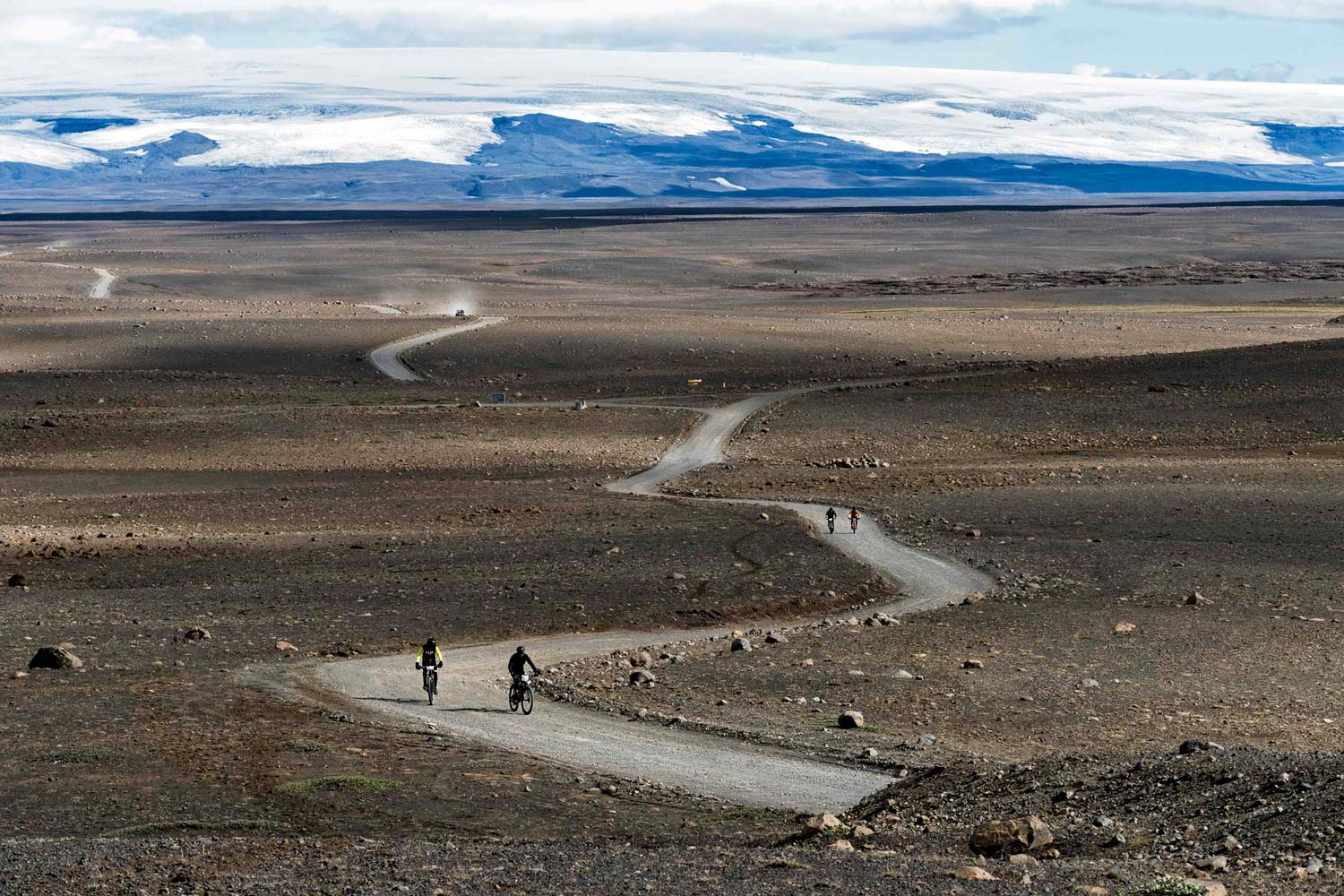
Finally up on the plateau, the landscape was stark and desolate. It looked like what I imagined the moon would look like. Rocks everywhere, with nothing else in sight but mountains of more rocks. The Langjökull glacier came into view on our right as Bergur and I started the process of chasing people down. The lead group had broken up on the climb, and we could see small groups in the distance.
I am a slow starter; it takes at least an hour for me to warm up, so I held on to Bergur’s wheel and took advantage of his slipstream as he set the pace on the relatively smooth gravel road. We caught some people, worked with them for awhile, then passed them. The road became rougher and it was a mental challenge to keep a good pace and keep the pedals turning consistently. I was thankful for my full-suspension 29er bike, and Bergur was thankful for his plus-sized tires on his hardtail with a Lauf fork.
After two hours we hit the first aid station. We had both been eating a lot more than we anticipated and had nearly run out of food. Thankfully, the aid station was well stocked with cookies! I took two packages and refilled my water, dumping my stash of Skratch Labs drink mix into my fresh bottles. “There are some nasty headwinds up ahead,” warned the volunteers at the aid station. “The leaders’ times are looking dramatically slower than last year’s.”
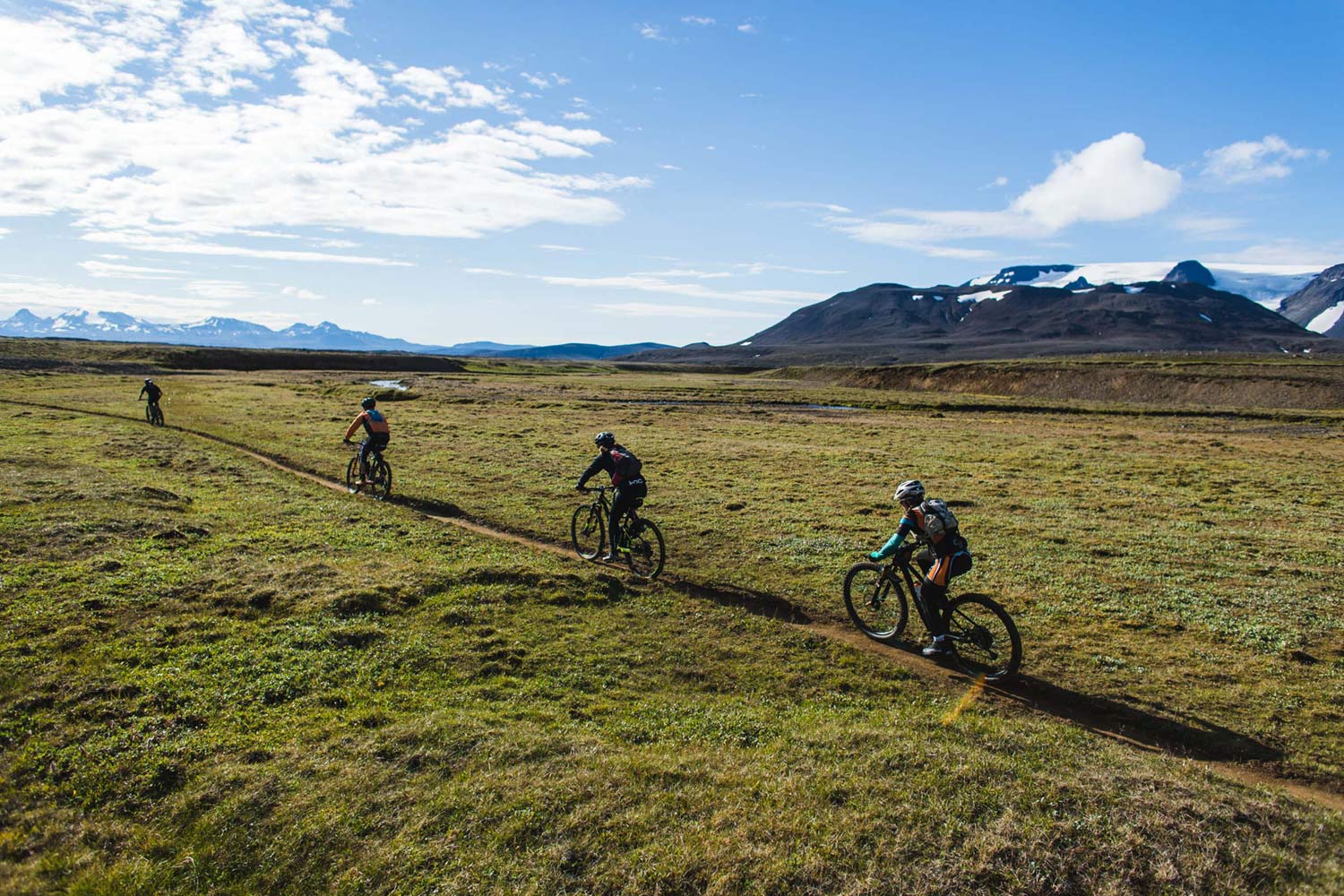
We headed off, and it wasn’t too long before Bergur started dropping back, unable to hold my pace. “My legs feel like shit,” he told me. He had let me know beforehand that his first day of racing is typically his hardest, and he bounces back the second day. He had also just spent two weeks on a boat, helping a friend sail from Quebec to Rhode Island, and had flown home just two days before the race started. Bergur had sea legs!
Coincidentally, I am the exact opposite. My first day of a stage race is strong, and my second day is a struggle, and I just have to maintain. Thankfully, my legs cooperated that day and felt powerful. I had a lot in the tank and I was warmed up. The headwinds were strong as predicted, and I pulled into them for the next three hours. Bergur sat on my wheel and held my pace, all the while heckling me that he had to do just as much work to find the tiny sliver of slipstream behind my five-foot-two frame.
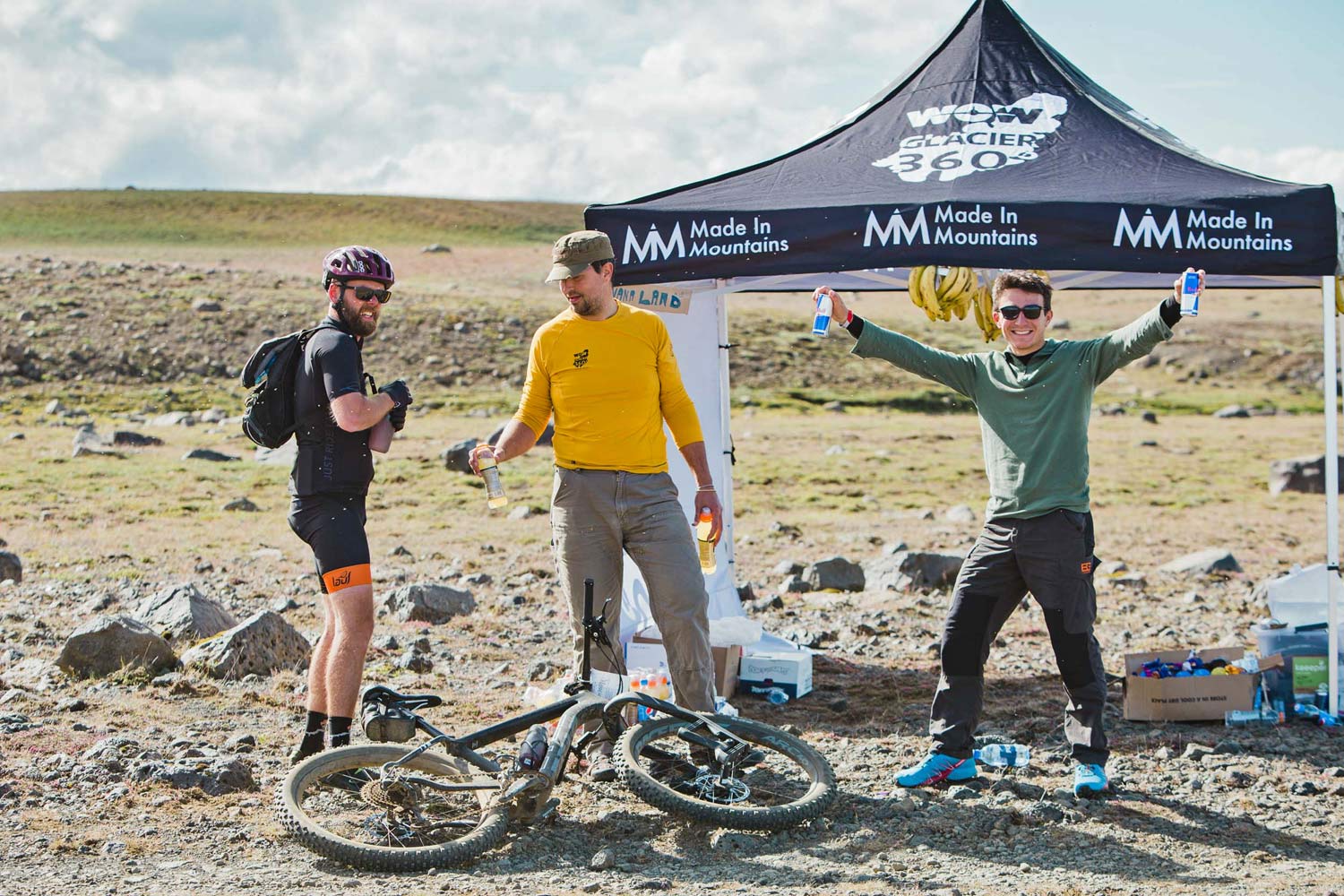
At the second aid station, we finally reached the top of the nearly five hour climb. All downhill from here — but it was a pedaly downhill, calling for strong legs and high speeds. Fortunately, we ran into another team of two who were happy to work with us. The four of us ran a high-speed, tight paceline that would make any road racers envious. We traded pulls for over an hour, tucking in when we could and cranking when it was our turn. I love that feeling!
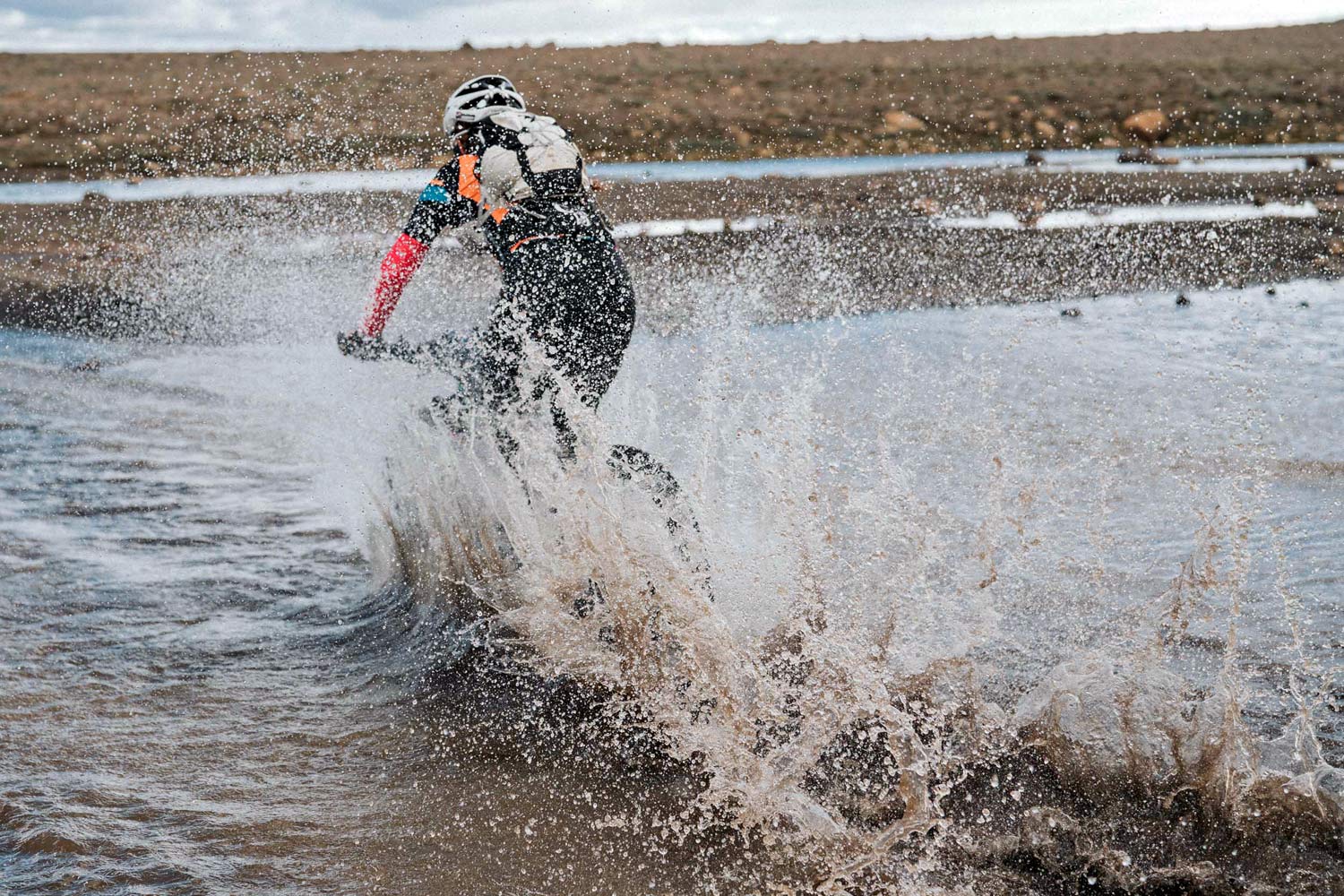
Finally, the road narrowed into singletrack and we had our first river crossing. We were told we would likely need to get off for this crossing; it was fast and rocky and reasonably deep. It came up so quickly around a corner that before I knew it I was steamrolling right through with Bergur on my wheel and a huge wave of water soaking us from head to toe. Our paceline comrades stopped, and we got away. Whooping and laughing, we raced to the finish line, the first of the mixed duos to cross that day. I was so thankful my legs had pulled through!
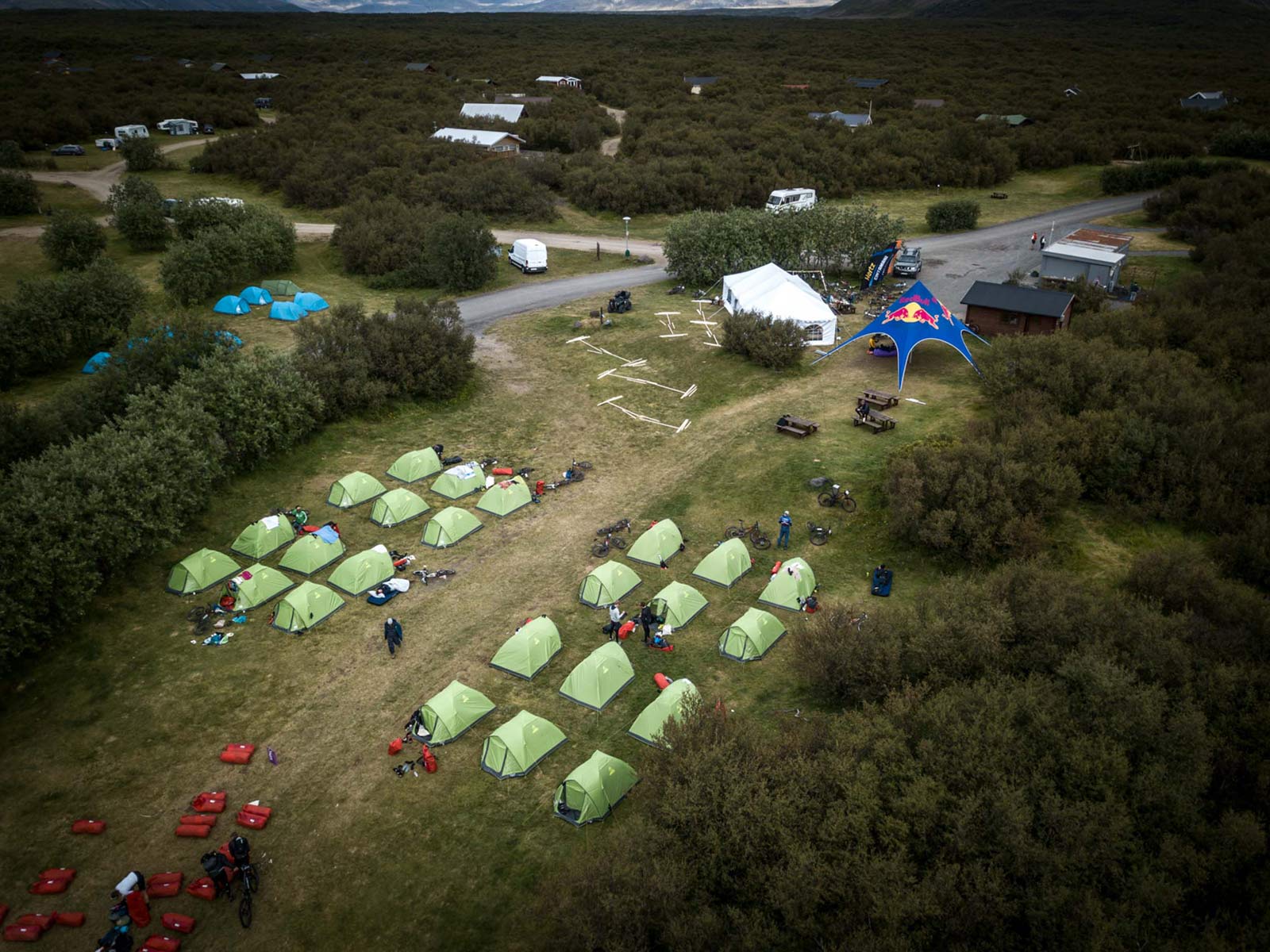
Now, time for recovery. I must say that this race had one of the best post-stage recovery setups I’ve ever seen. We rolled into camp and all of our tents (supplied by the race) had been set up for us and our sleeping mats inflated. We didn’t have to do any work. There was a big tent with heaps of nourishing food from freshly grilled chicken skewers to two different types of Asian-inspired noodle dishes to sweet snacks and fruits. The number one most important element in recovery for a stage race is making sure to eat within 30 minutes of finishing, and this was no problem at the Glacier360.
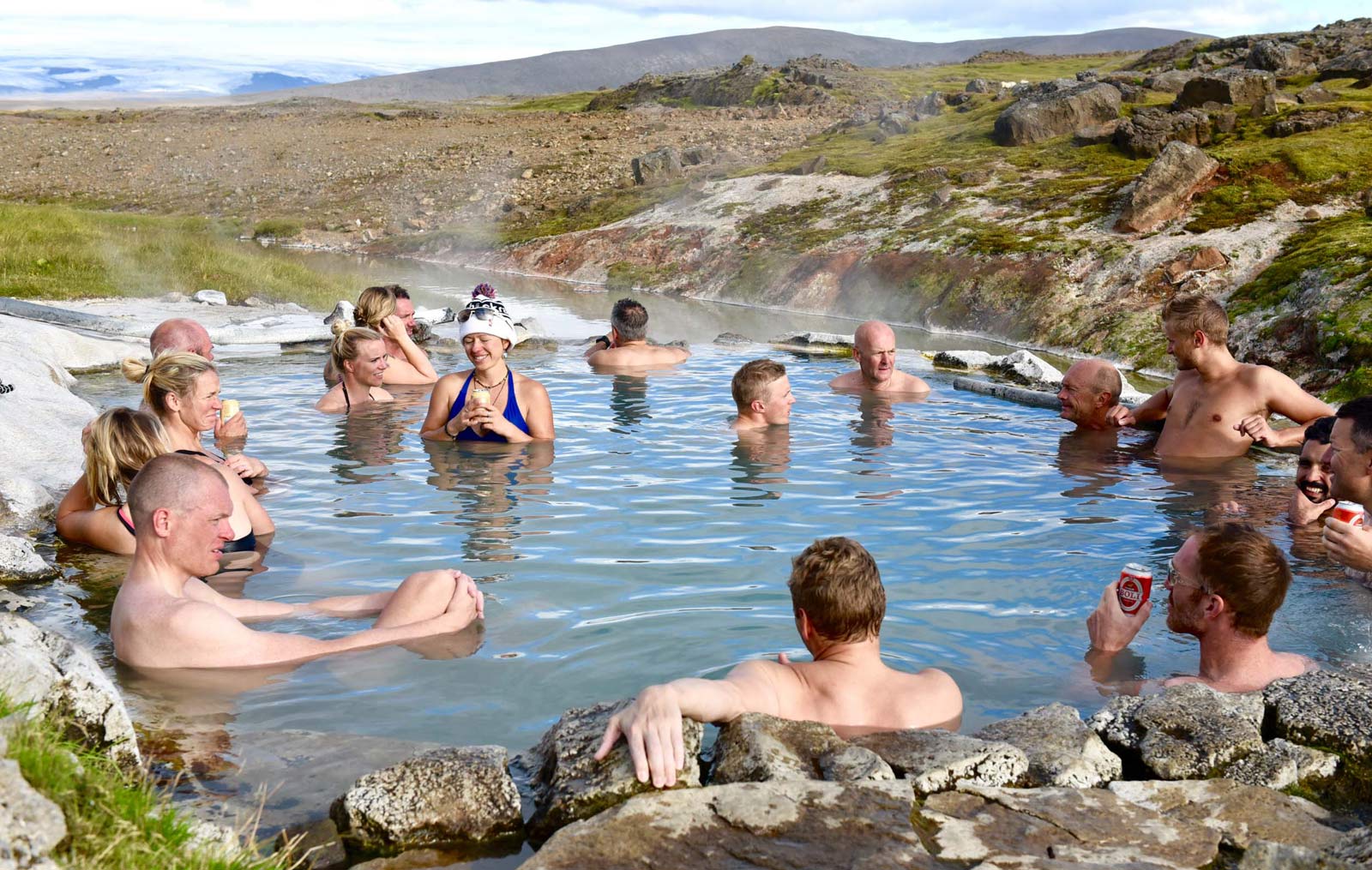
Then, the hot springs. These natural thermal soaking pools are everywhere you look in Iceland, and this alone is reason enough to do this race. We lowered our tired bodies into the healing waters, being sure to have our recovery drinks and water with us to stay hydrated. Racers sharing their stories from the day, talking about what the riding is like in their native countries, and hearing the many languages going around were highlights of the post-race soaking time. Dinner the first night was buffet-style, delicious, and I may have gone back for thirds.
GLACIER360 – DAY TWO
On the morning of the second day we were again greeted with sunshine. An air of trepidation hung over the breakfast table, however, as all the racers talked nervously about “the” upcoming river crossing. Today was the day with a deep river crossing only 20 km into the race, rumored to be knee to thigh deep, and with a fast enough current that they had strung a line across the river for racers to hold on to as they crossed and had race volunteers there to help if anyone went for a swim.
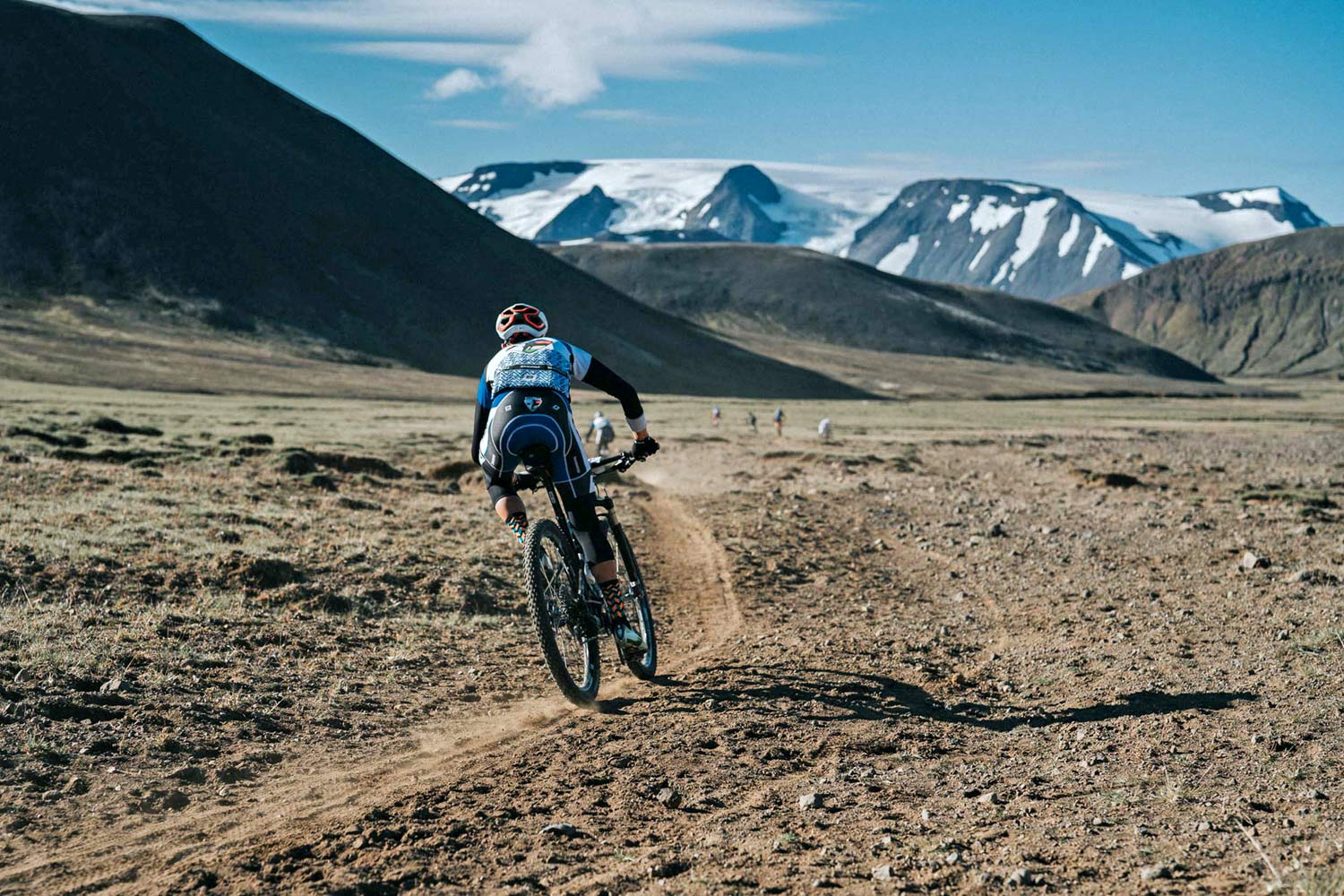
Day two was also the longest day at 111 km. That is a long time to be cold and wet. Racers debated whether they would stop and take off their shoes and socks, bring a fresh pair of socks to change into after they had walked through, or just slog through and ride the day with wet feet. This was only the deepest of many river crossings on the second day. With the chilly winds and temperatures, everyone was a bit concerned about being wet.
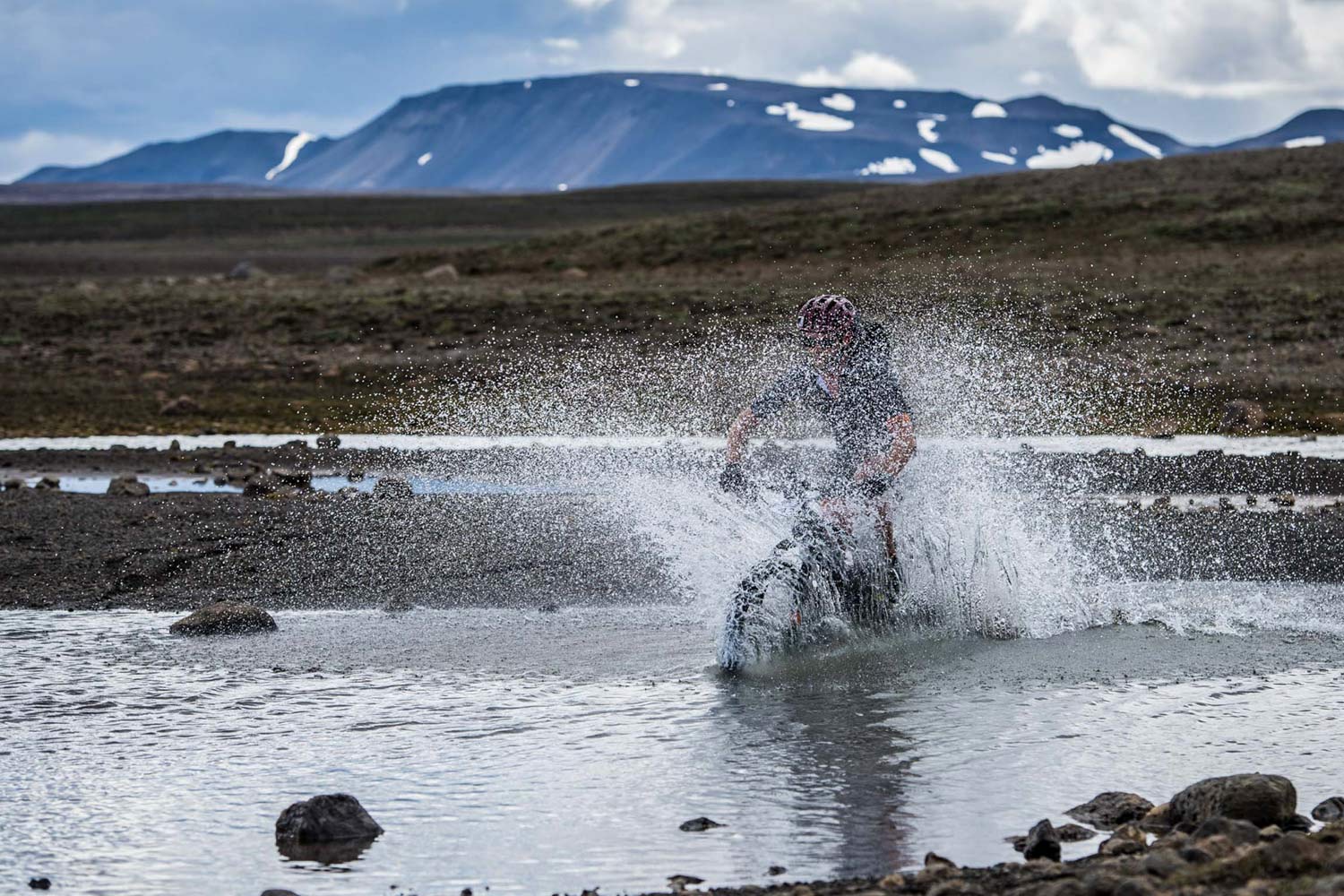
Bergur and I discussed it, and decided we were going to just be wet and ride through every crossing possible. We both had neoprene socks and shoe covers, and we were hoping these would keep us warm enough and offer some protection against the wind. “If we get cold, we’ll just ride faster! Besides, I’m already sweating my ass off,” said Bergur with a grin. Cue the laughter and eye rolling from me. We were in the lead in mixed duos and had a strong standing in the open men’s field, and we were not about to slow down for shoe and sock changes.
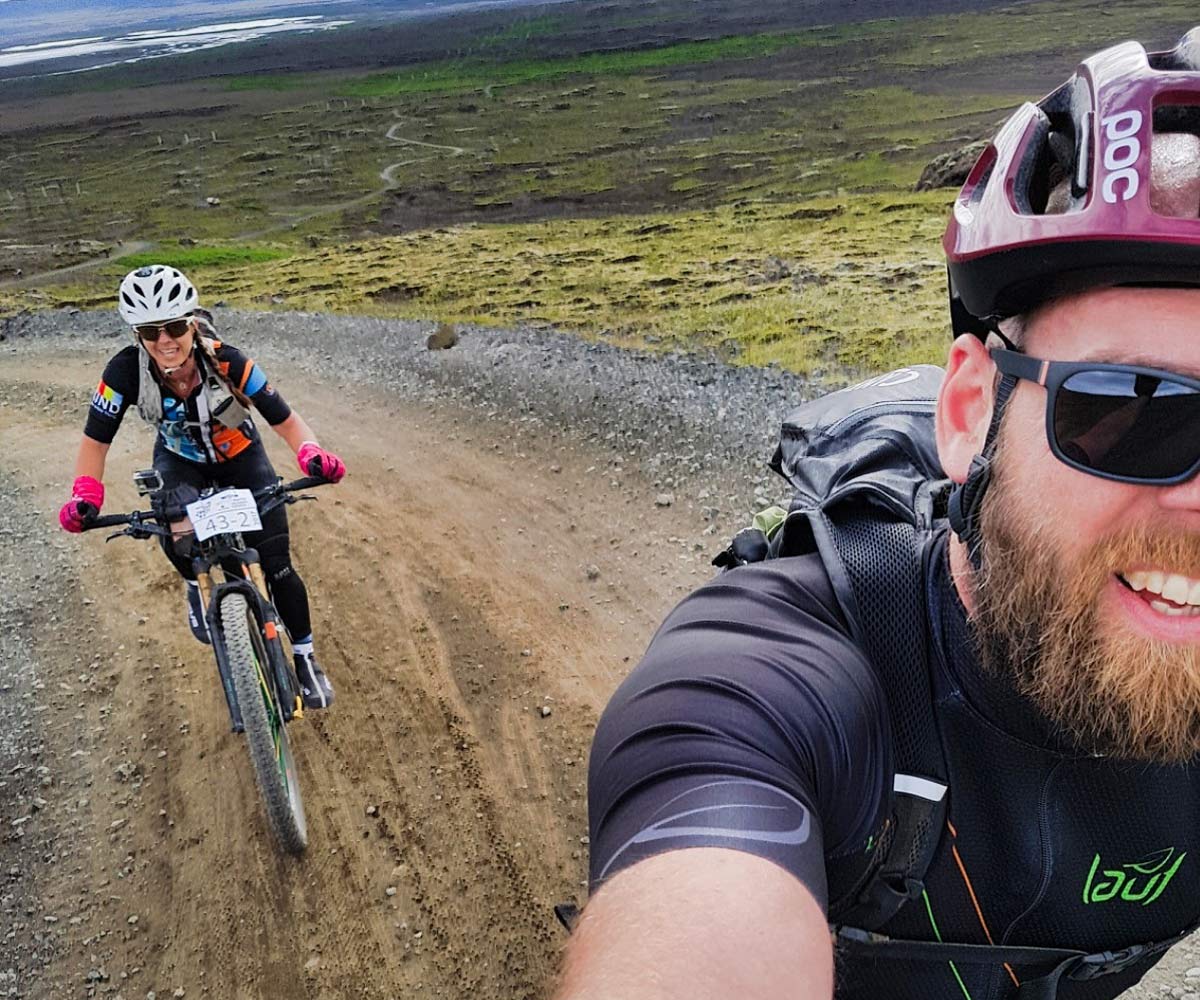
Once again the race started fast and we found ourselves in the lead group with a handful of men’s teams and a few of the top women’s teams. My legs did not have the snap in them that they had the previous day, and I struggled to hold Bergur’s wheel as I fell off the pace and he pulled me back up to the leaders. Finally, we had some distance on the rest of the field, and a strong group to work with. I hid from the wind in the middle of the group and tried to recover.
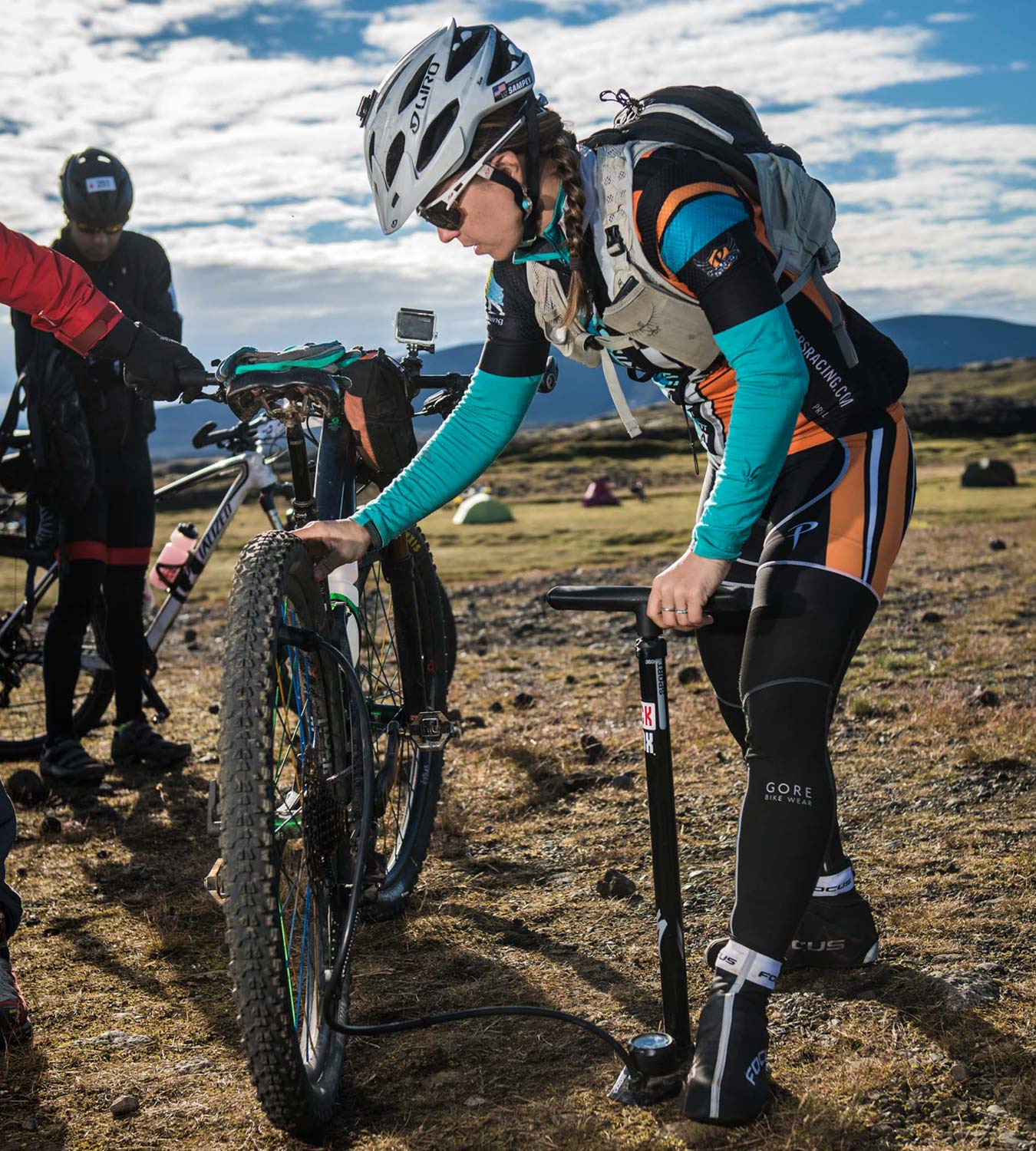
All of a sudden I felt like my legs were made of lead and I couldn’t keep the pace anymore. “I’m cracked,” I said to Bergur as I fell back from the group. He looked back at me. “Your rear tire is flat!” Aw shit. Who gets a flat tire on a gravel road? Me, I guess. I must have burped it on a rock near the start. We filled it with air, hoping my sealant would do its job as we watched the group we had worked so hard to stick with ride away and other teams roll past us. Ugh, how lame! We got back on the road and I tried to shake it off and focus on keeping a steady pace. We had a long way to go and technical terrain ahead — I knew we could catch back up.
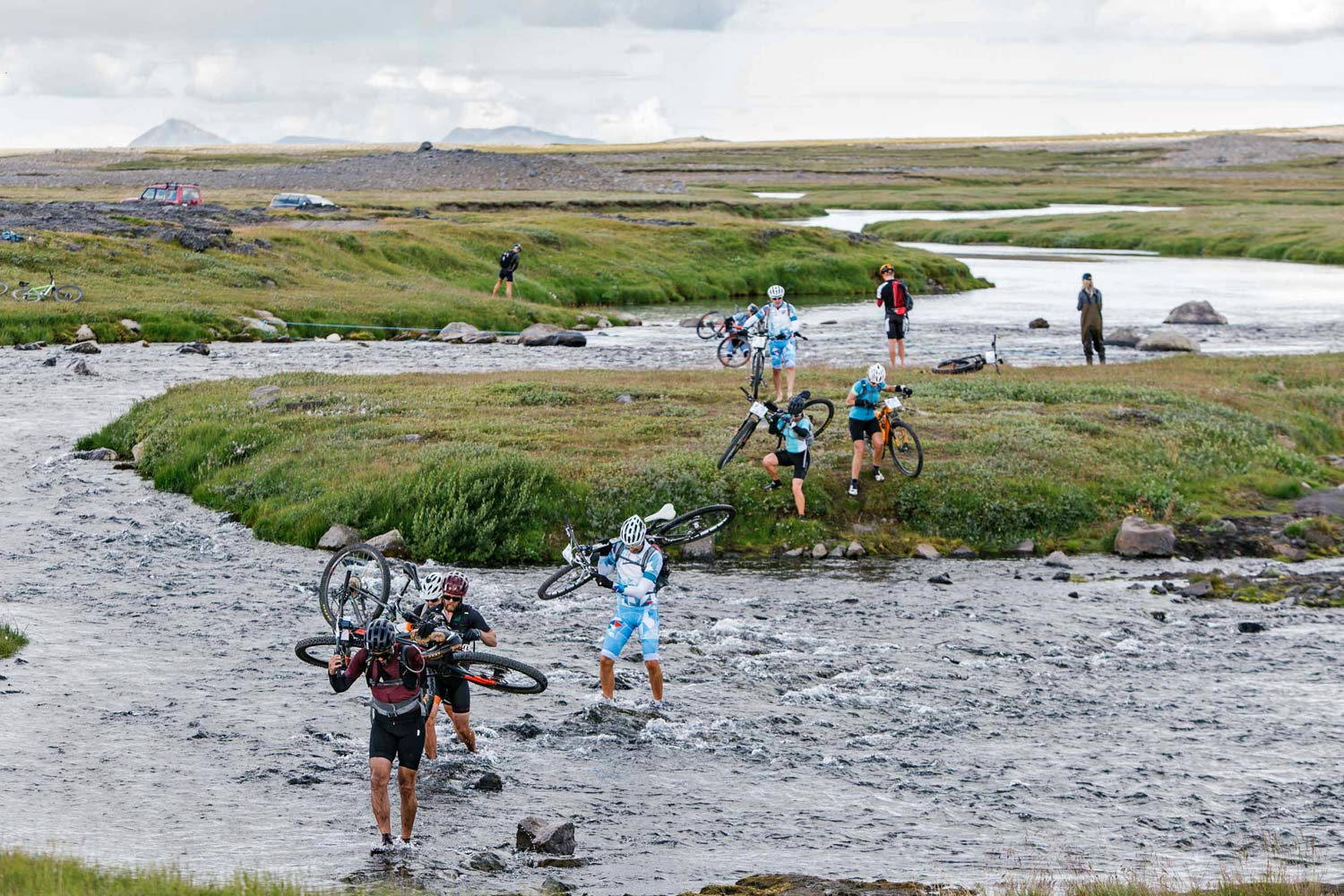
In no time, 20 kilometers had passed and we came upon the river crossing. Many racers were sitting on the ground, taking off their shoes. I saw some of them going across the line. “Yikes. That IS deep and fast — especially for small people!” I shouldered my bike, grabbed the line and followed Bergur across. It was a long crossing, and somewhere near the center it reached the middle of my thighs. The river grabbed hold of the front wheel of my bike, pulling it into me and making me stumble. Shit! I slowed my pace and struggled to lift my bike higher, gripping the line as I made my way forward with tiny steps, focusing on putting one foot in front of the other.
Then, Bergur appeared in front of me. He had made it to the other side and saw that the current was dragging my bike wheel into me. He grabbed my bike out of the water and I was able to scurry across and out the other side. “Whoa. Thanks man.” I was wide-eyed and shivering cold as I jumped back on my bike. My legs were icicles and didn’t want to move. I talked to them, spinning a fast cadence in hopes they would slowly warm up again.
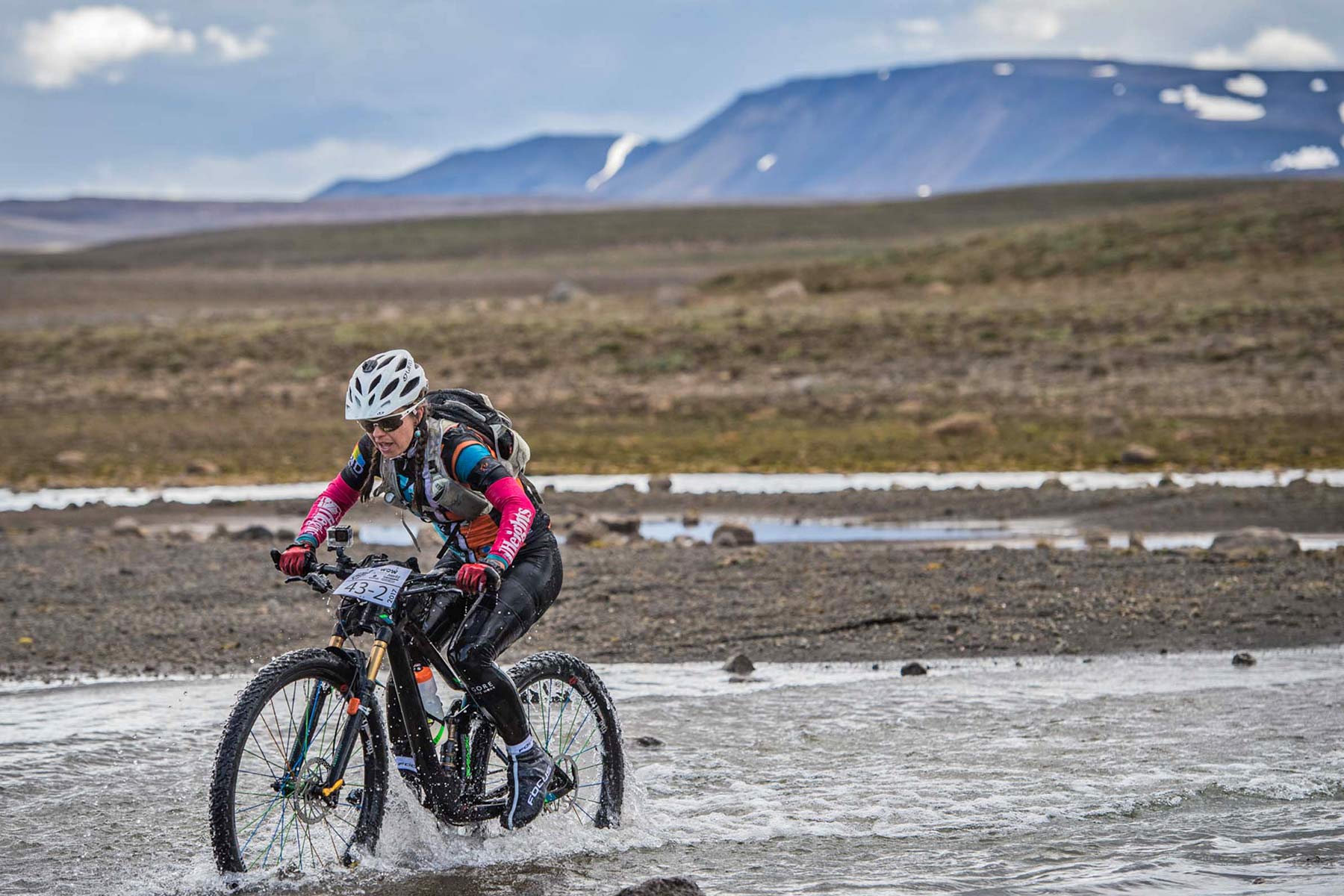
This would prove to be a brutal, extremely mentally challenging day as the “road” quickly turned rough and technical, requiring lots of focus to keep a fast pace. While the first day was nearly all climbing until the end, the second day was variable: steep power climbs, technical descents, tricky rock moves both up and down, and rough pedaling through chilly, whipping winds across an exposed plateau that felt endless. The sky spit rain and hail on and off. The river crossings kept coming — I lost count at eight. Most of them were deep but rideable, and each time my legs would take awhile to warm back up from the frigid glacial water.
Bergur and I were having fun on the technical terrain, both riding well, and although my legs weren’t snappy I was still moving at a decent pace. We started passing people who were struggling on the rocks. Again, I thanked my lucky stars (or my bike sponsor) that I had a full-suspension bike for this race, with 29 inch wheels that helped me float over the rocks.
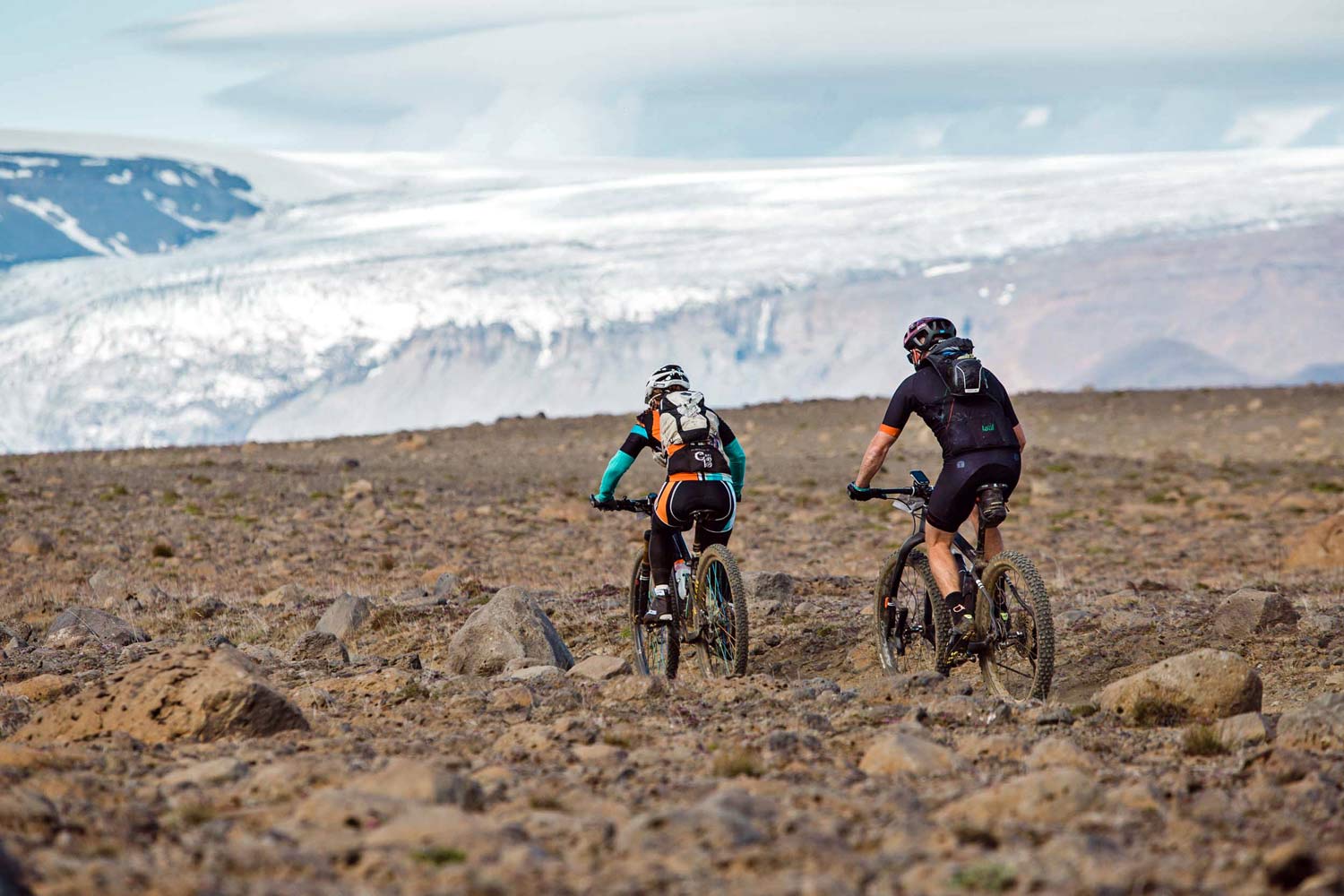
At the final aid station, we caught the top UCI Elite women’s team. A pair of Icelandic women who Bergur had said were exceptionally strong on the road. We rode together for awhile, trading leads, before I picked up the pace and we moved ahead. Bergur told me we needed to get as much time on them as possible through the rock gardens, as the final 25k was a fast road section into the wind. I put my head down and focused on riding as smoothly and cleanly as possible.
As we crested the final climb out to the road, I looked back and saw we had about a two-minute gap on the UCI team. “Go, go!” I yelled to Bergur. I tucked in to the draft as Bergur started hammering. “How do you feel?” I yelled. “Great! You?” “I still don’t have any snap in my legs, but I’ll do my best to hold on!” And that is exactly what happened for the next 25km as the leading women’s team chased us down and we managed to barely stay ahead. I turned myself inside out to hold Bergur’s wheel and played the wind the best I could, shifting from one side of his rear wheel to the other as the wind direction changed. I knew I needed every bit of help I could get.
The final climb was steep and looked about five minutes long, and I seriously thought I was going to just fall right off my bike and we would get caught. I looked back and our gap had narrowed to about 30 seconds. I gave it everything I had, and somehow my legs responded. We crested the hill and I jumped back on Bergur’s wheel as we gave our last bit of energy to pull into the singletrack ahead. We crossed the line less than a minute ahead of them, turning around to cheer them in. We all laughed, hugged, and high-fived, exhausted but thrilled to have had such fun and close competition to push us all beyond our limits.
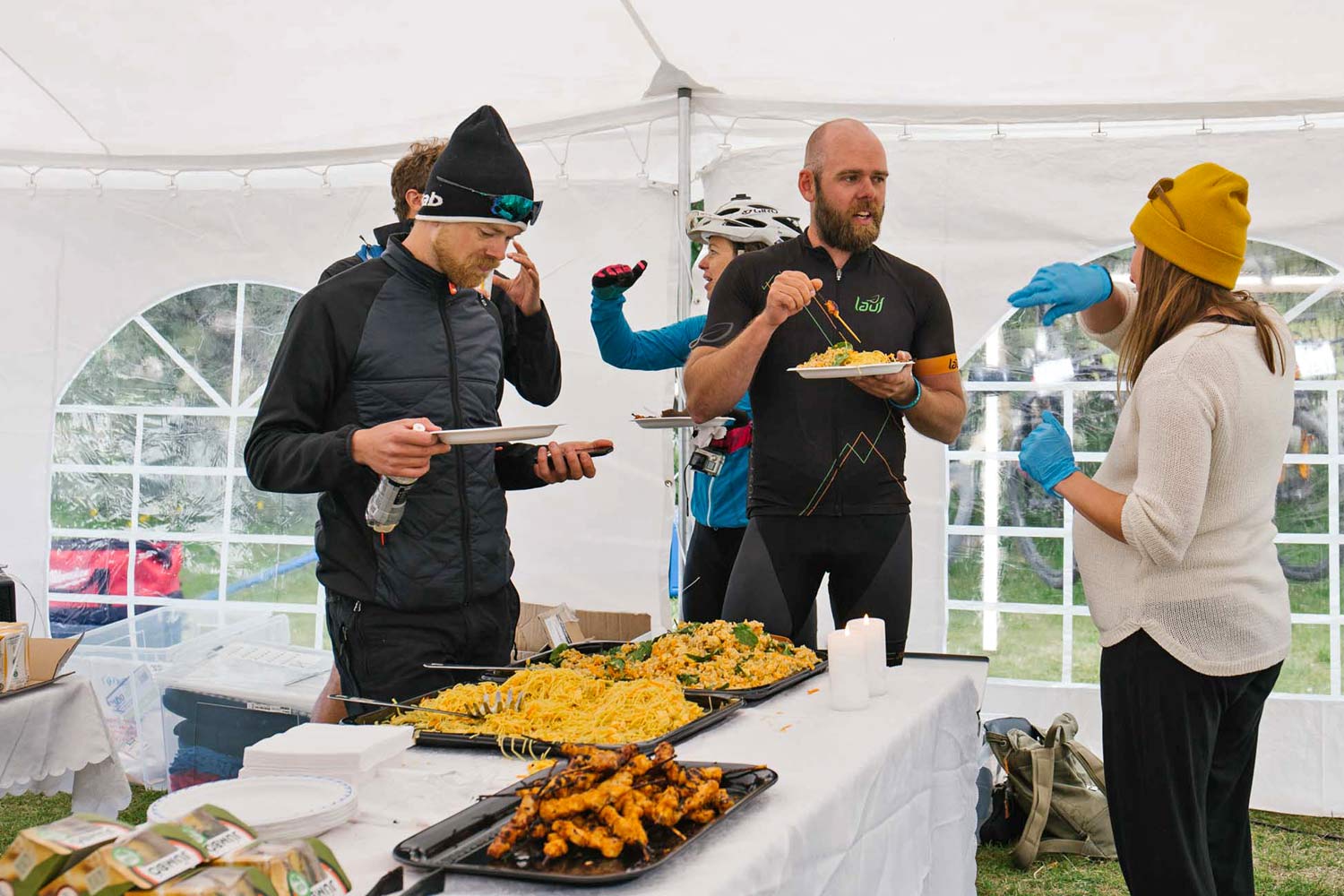
I shuffled to the food tent, completely spent, and devoured several steaming hot chicken skewers atop a mound of noodles. If I hadn’t done so much stage racing I would have been seriously worried about my ability to continue on the next day. In fact, many teams dropped out of the race at some point during or after the second day, it was so mentally challenging. Anyone who does this race should be well-prepared for this day. It is tough and will crack a lot of people. You have to be tougher. Besides, there are the most incredible hot springs in the world waiting for you at the finish line!
The place we were camped for the second night was high in the remote Icelandic highlands, and it is a natural thermal preserve with a huge rock-lined soaking pool and many sulfur steam vents and pools hissing and bubbling nearby. It was otherworldly, and the stunning sunset casting its alpenglow on the looming glacier in the distance only made it more so. All the racers bonded over our shared experience of suffering that day as we lingered in the hot pool until we finally heard the dinner bell. I stuffed my face and sucked down bottles of Skratch Labs recovery mix, willing my body to make a comeback for the final day. Just as dinner finished rain began to fall, and Bergur and I dove for our tent as the skies opened up and our camp was drenched by the cold Icelandic torrents.
GLACIER360 – DAY THREE
In the morning, it was breezy and cloudy but the rain had subsided by the time all the racers stumbled out of our tents and readied for another long day in the saddle. This was the “downhill day,” with more total elevation lost than gained, but I knew it would be an Icelandic downhill: rough, technical, and still a lot of pedaling work. I knew it would be anything but easy. We started with an uphill road climb, and Bergur and I were happy to find that we both felt pretty good. Our legs warmed up nicely as we got into position for the singletrack. Then it was game on!
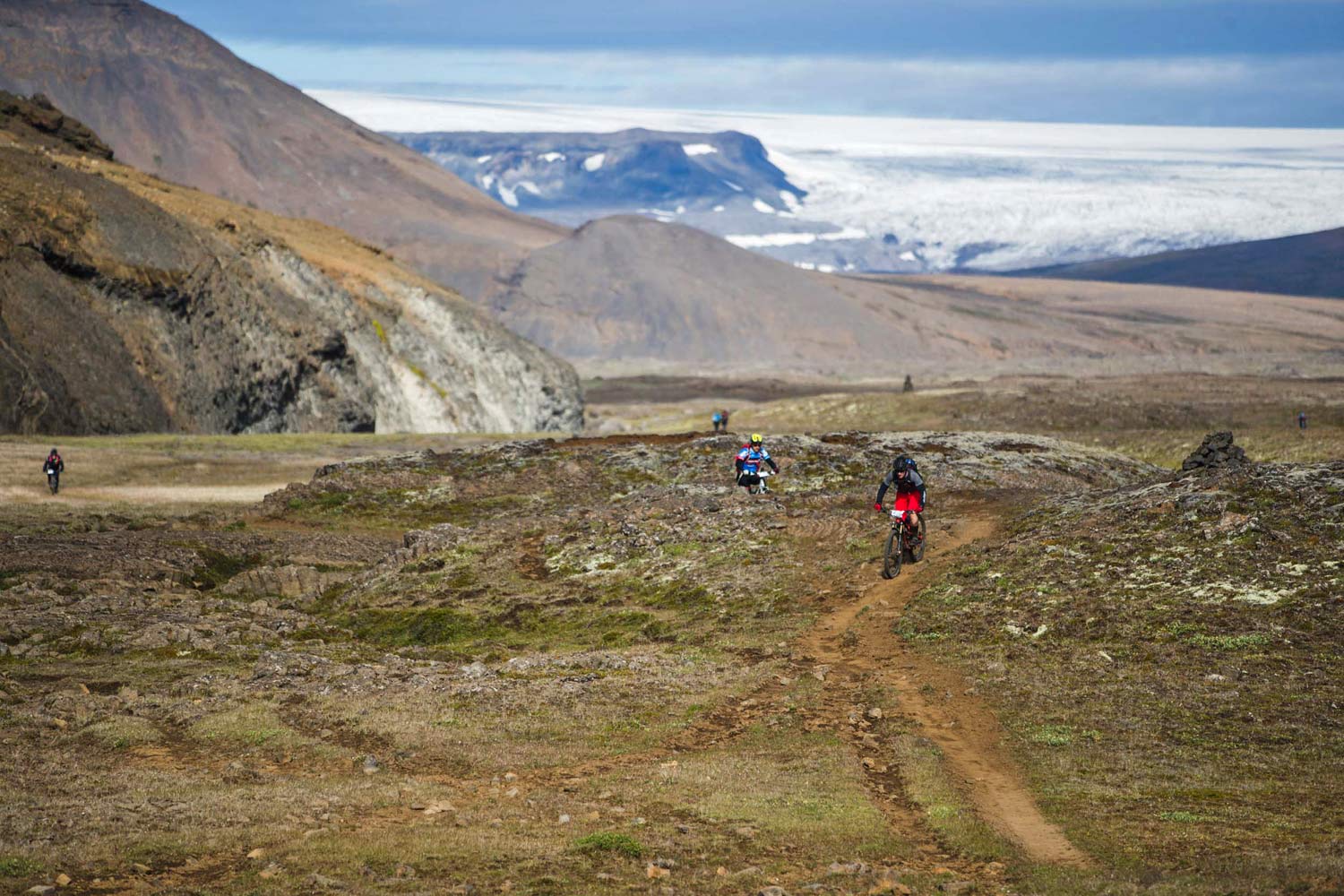
Much of the Icelandic singletrack we were riding on is actually multi-track, with two to six different singletracks to choose from. Some were shallow and easy to pedal in; some turned into deep trenches, and the key was to look well ahead and choose the best line you could see. Bergur and I knew we could ride well and gain position in the technical sections, and we gradually passed people as we motored over the rocks.
This day required complete and intense focus to not get hung up on the rocks or in deep trenches, but every so often I got to look up and see where we were: in a field of volcanic rock making our way down an enormous valley next to a roaring glacial river, with mountains all around. It was hard not to stop for photos, but we were racing!
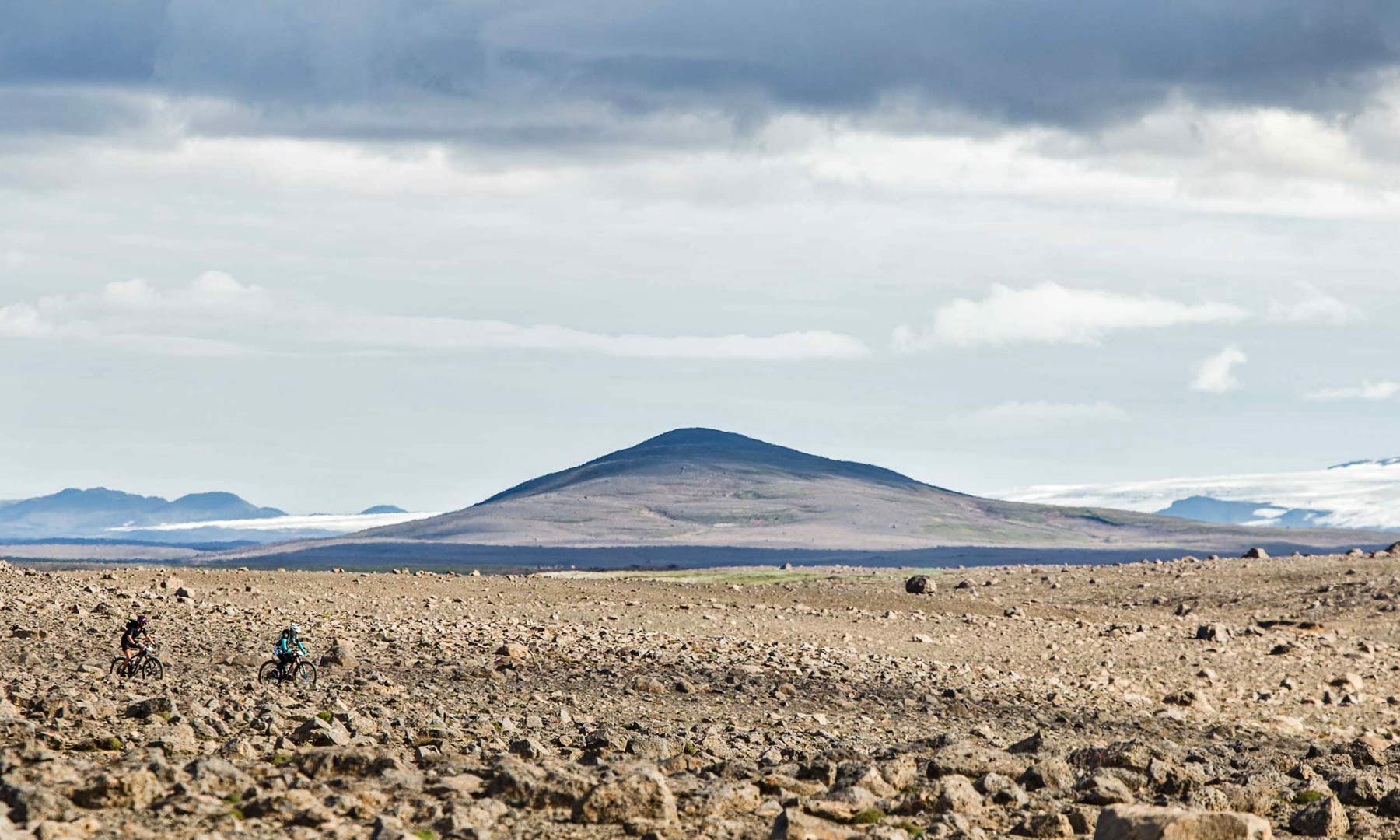
After a few hours of negotiating the never-ending rock garden, I started to lose focus and forgot how to ride a bike, bashing my pedals everywhere and feeling generally awkward. Ugh. It was all I could do not to crack my shits and throw my bike into the river. Bergur was bumping along a few bike lengths behind me and I wondered if he felt the same. “Just keep moving, just keep moving,” I told myself. Then I rammed my front wheel straight into a rock and came off the bike into a perfectly placed pile of sheep dung. Oops. Don’t screw this up now! That knocked me out of my daze and I picked up the pace.
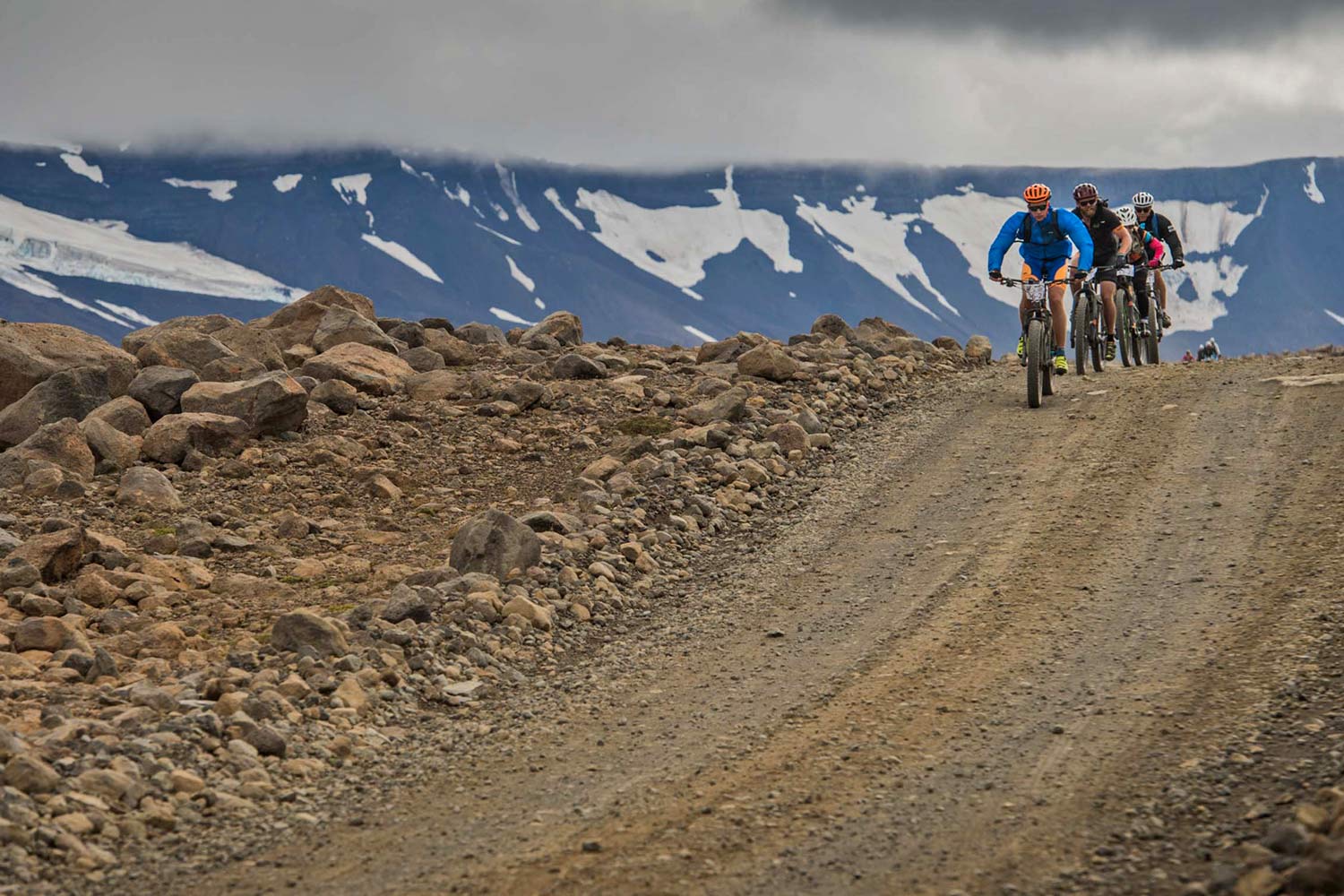
We finally emerged from the rock minefield and onto a gravel road. I was grateful for the break and we pedaled easy for a few kilometers, out in no man’s land with nothing and no one in sight. Bergur and I chatted a bit and I tried not to think about beer and a cheeseburger. Then we saw two teams starting to catch up to us on a long climb. I had no doubt they saw us as well, and we were their carrot. It was time to pick up the pace. We checked in with each other. “How are you feeling?… yeah, great!”
We both felt strong, so we cranked it up and traded leads, up and down hills and across the flats, riding smoothly and using solid teamwork to stay away from the riders chasing us down. Each time I would take a pull I rode as hard as I could. Then when I started to tire Bergur would take over, and I would think “dang, I wonder if I can do that again?” But after a few minutes of recovery and I would notice Bergur start to slow, I would be able to surge forward and hold the pace again. We caught and passed another team, and rode in strong to the finish.
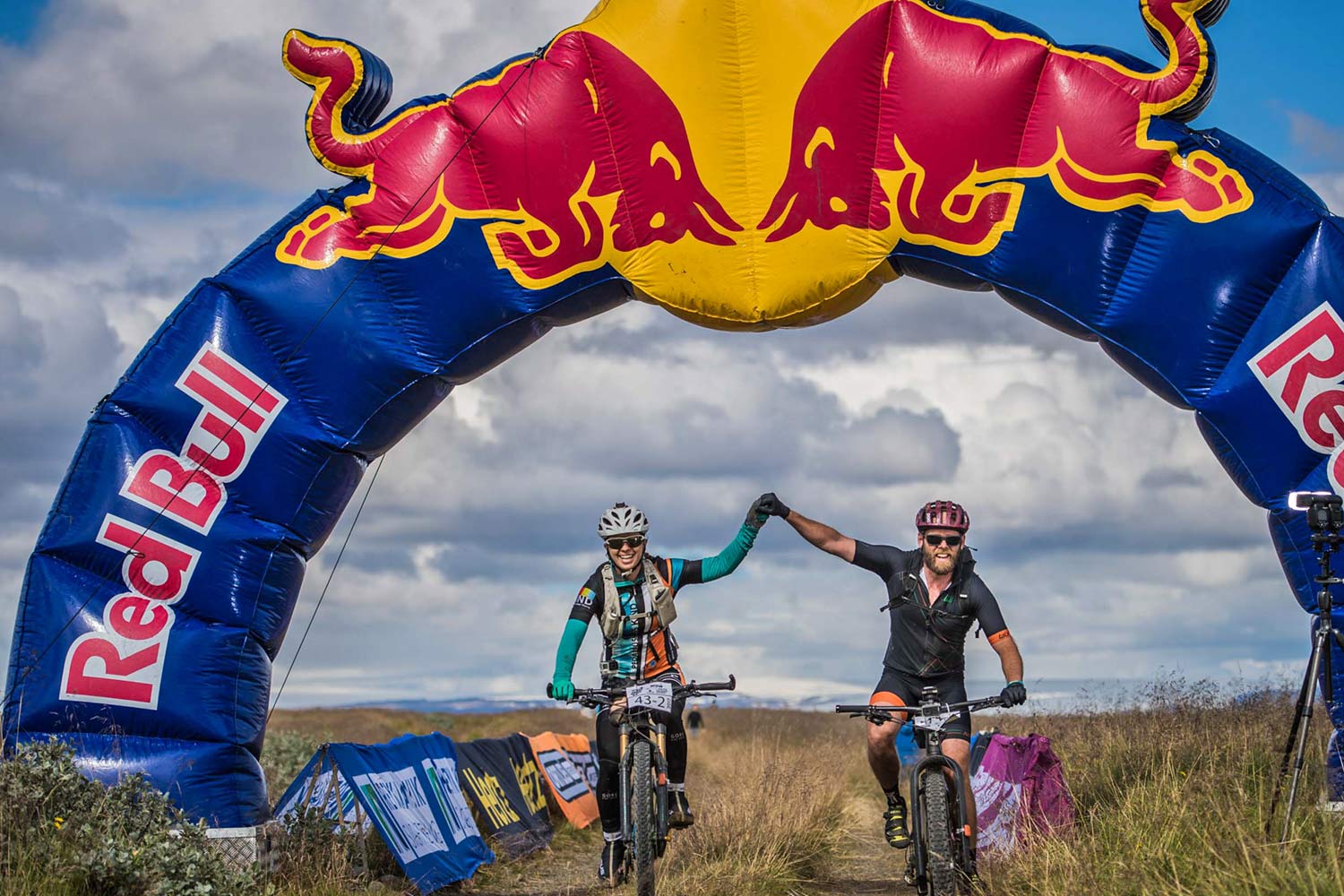
“You are the first woman across the line!” one of the volunteers told me as Bergur and I were each handed a Red Bull while we hugged and high-fived. We had done it! Just finishing this grueling race was a huge accomplishment, we had won the mixed duos category, and as it turned out our time had landed us third in the open men’s category as well.
We had ridden strong as a team, our individual strengths and weaknesses had played well together, and we were so lucky to have had great weather every day. Apart from strong winds and a bit of rain and hail, the Icelandic weather gods had smiled on us for three days in a row, which is extremely rare. We jumped on the bus that whisked all the racers off to the post-race celebration: food, beer, awards, music, the trading of sufferfest stories, and yes, more hot pools to soak our tired bodies. It is Iceland, after all.
The 2019 version of Glacier 360 is a UCI class 2 stage event (S2) and will be the first race in Iceland to receive a UCI standing. If you are up for a challenge in a well organized race with amazing scenery in the highlands of Iceland make sure to register at: Glacier360.is
For more action from previous versions check out Glacier360’s YouTube channel.
